Input interpretation

KClO_3 potassium chlorate + HBr hydrogen bromide ⟶ H_2O water + KCl potassium chloride + Br_2 bromine
Balanced equation
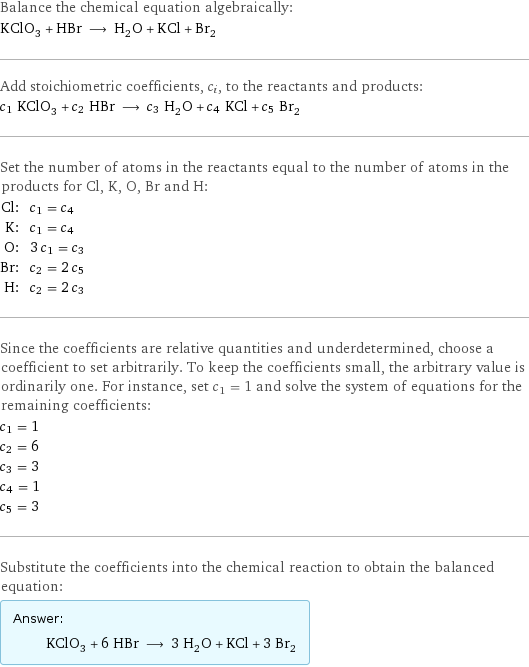
Balance the chemical equation algebraically: KClO_3 + HBr ⟶ H_2O + KCl + Br_2 Add stoichiometric coefficients, c_i, to the reactants and products: c_1 KClO_3 + c_2 HBr ⟶ c_3 H_2O + c_4 KCl + c_5 Br_2 Set the number of atoms in the reactants equal to the number of atoms in the products for Cl, K, O, Br and H: Cl: | c_1 = c_4 K: | c_1 = c_4 O: | 3 c_1 = c_3 Br: | c_2 = 2 c_5 H: | c_2 = 2 c_3 Since the coefficients are relative quantities and underdetermined, choose a coefficient to set arbitrarily. To keep the coefficients small, the arbitrary value is ordinarily one. For instance, set c_1 = 1 and solve the system of equations for the remaining coefficients: c_1 = 1 c_2 = 6 c_3 = 3 c_4 = 1 c_5 = 3 Substitute the coefficients into the chemical reaction to obtain the balanced equation: Answer: | | KClO_3 + 6 HBr ⟶ 3 H_2O + KCl + 3 Br_2
Structures

+ ⟶ + +
Names

potassium chlorate + hydrogen bromide ⟶ water + potassium chloride + bromine
Reaction thermodynamics
Enthalpy
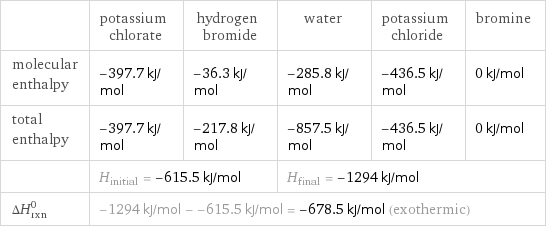
| potassium chlorate | hydrogen bromide | water | potassium chloride | bromine molecular enthalpy | -397.7 kJ/mol | -36.3 kJ/mol | -285.8 kJ/mol | -436.5 kJ/mol | 0 kJ/mol total enthalpy | -397.7 kJ/mol | -217.8 kJ/mol | -857.5 kJ/mol | -436.5 kJ/mol | 0 kJ/mol | H_initial = -615.5 kJ/mol | | H_final = -1294 kJ/mol | | ΔH_rxn^0 | -1294 kJ/mol - -615.5 kJ/mol = -678.5 kJ/mol (exothermic) | | | |
Gibbs free energy
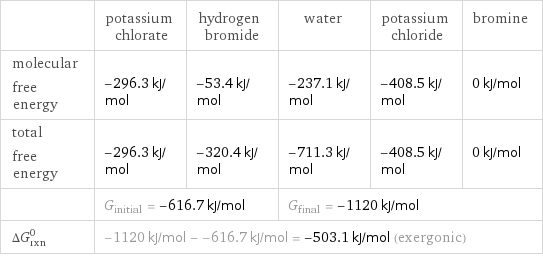
| potassium chlorate | hydrogen bromide | water | potassium chloride | bromine molecular free energy | -296.3 kJ/mol | -53.4 kJ/mol | -237.1 kJ/mol | -408.5 kJ/mol | 0 kJ/mol total free energy | -296.3 kJ/mol | -320.4 kJ/mol | -711.3 kJ/mol | -408.5 kJ/mol | 0 kJ/mol | G_initial = -616.7 kJ/mol | | G_final = -1120 kJ/mol | | ΔG_rxn^0 | -1120 kJ/mol - -616.7 kJ/mol = -503.1 kJ/mol (exergonic) | | | |
Entropy
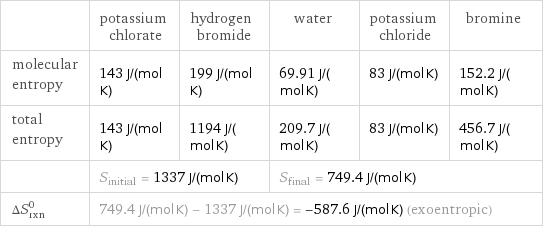
| potassium chlorate | hydrogen bromide | water | potassium chloride | bromine molecular entropy | 143 J/(mol K) | 199 J/(mol K) | 69.91 J/(mol K) | 83 J/(mol K) | 152.2 J/(mol K) total entropy | 143 J/(mol K) | 1194 J/(mol K) | 209.7 J/(mol K) | 83 J/(mol K) | 456.7 J/(mol K) | S_initial = 1337 J/(mol K) | | S_final = 749.4 J/(mol K) | | ΔS_rxn^0 | 749.4 J/(mol K) - 1337 J/(mol K) = -587.6 J/(mol K) (exoentropic) | | | |
Equilibrium constant
![Construct the equilibrium constant, K, expression for: KClO_3 + HBr ⟶ H_2O + KCl + Br_2 Plan: • Balance the chemical equation. • Determine the stoichiometric numbers. • Assemble the activity expression for each chemical species. • Use the activity expressions to build the equilibrium constant expression. Write the balanced chemical equation: KClO_3 + 6 HBr ⟶ 3 H_2O + KCl + 3 Br_2 Assign stoichiometric numbers, ν_i, using the stoichiometric coefficients, c_i, from the balanced chemical equation in the following manner: ν_i = -c_i for reactants and ν_i = c_i for products: chemical species | c_i | ν_i KClO_3 | 1 | -1 HBr | 6 | -6 H_2O | 3 | 3 KCl | 1 | 1 Br_2 | 3 | 3 Assemble the activity expressions accounting for the state of matter and ν_i: chemical species | c_i | ν_i | activity expression KClO_3 | 1 | -1 | ([KClO3])^(-1) HBr | 6 | -6 | ([HBr])^(-6) H_2O | 3 | 3 | ([H2O])^3 KCl | 1 | 1 | [KCl] Br_2 | 3 | 3 | ([Br2])^3 The equilibrium constant symbol in the concentration basis is: K_c Mulitply the activity expressions to arrive at the K_c expression: Answer: | | K_c = ([KClO3])^(-1) ([HBr])^(-6) ([H2O])^3 [KCl] ([Br2])^3 = (([H2O])^3 [KCl] ([Br2])^3)/([KClO3] ([HBr])^6)](../image_source/c550cdaed94b212dd28cf06225592807.png)
Construct the equilibrium constant, K, expression for: KClO_3 + HBr ⟶ H_2O + KCl + Br_2 Plan: • Balance the chemical equation. • Determine the stoichiometric numbers. • Assemble the activity expression for each chemical species. • Use the activity expressions to build the equilibrium constant expression. Write the balanced chemical equation: KClO_3 + 6 HBr ⟶ 3 H_2O + KCl + 3 Br_2 Assign stoichiometric numbers, ν_i, using the stoichiometric coefficients, c_i, from the balanced chemical equation in the following manner: ν_i = -c_i for reactants and ν_i = c_i for products: chemical species | c_i | ν_i KClO_3 | 1 | -1 HBr | 6 | -6 H_2O | 3 | 3 KCl | 1 | 1 Br_2 | 3 | 3 Assemble the activity expressions accounting for the state of matter and ν_i: chemical species | c_i | ν_i | activity expression KClO_3 | 1 | -1 | ([KClO3])^(-1) HBr | 6 | -6 | ([HBr])^(-6) H_2O | 3 | 3 | ([H2O])^3 KCl | 1 | 1 | [KCl] Br_2 | 3 | 3 | ([Br2])^3 The equilibrium constant symbol in the concentration basis is: K_c Mulitply the activity expressions to arrive at the K_c expression: Answer: | | K_c = ([KClO3])^(-1) ([HBr])^(-6) ([H2O])^3 [KCl] ([Br2])^3 = (([H2O])^3 [KCl] ([Br2])^3)/([KClO3] ([HBr])^6)
Rate of reaction
![Construct the rate of reaction expression for: KClO_3 + HBr ⟶ H_2O + KCl + Br_2 Plan: • Balance the chemical equation. • Determine the stoichiometric numbers. • Assemble the rate term for each chemical species. • Write the rate of reaction expression. Write the balanced chemical equation: KClO_3 + 6 HBr ⟶ 3 H_2O + KCl + 3 Br_2 Assign stoichiometric numbers, ν_i, using the stoichiometric coefficients, c_i, from the balanced chemical equation in the following manner: ν_i = -c_i for reactants and ν_i = c_i for products: chemical species | c_i | ν_i KClO_3 | 1 | -1 HBr | 6 | -6 H_2O | 3 | 3 KCl | 1 | 1 Br_2 | 3 | 3 The rate term for each chemical species, B_i, is 1/ν_i(Δ[B_i])/(Δt) where [B_i] is the amount concentration and t is time: chemical species | c_i | ν_i | rate term KClO_3 | 1 | -1 | -(Δ[KClO3])/(Δt) HBr | 6 | -6 | -1/6 (Δ[HBr])/(Δt) H_2O | 3 | 3 | 1/3 (Δ[H2O])/(Δt) KCl | 1 | 1 | (Δ[KCl])/(Δt) Br_2 | 3 | 3 | 1/3 (Δ[Br2])/(Δt) (for infinitesimal rate of change, replace Δ with d) Set the rate terms equal to each other to arrive at the rate expression: Answer: | | rate = -(Δ[KClO3])/(Δt) = -1/6 (Δ[HBr])/(Δt) = 1/3 (Δ[H2O])/(Δt) = (Δ[KCl])/(Δt) = 1/3 (Δ[Br2])/(Δt) (assuming constant volume and no accumulation of intermediates or side products)](../image_source/33c715009130f607a191ecc8b7651fe5.png)
Construct the rate of reaction expression for: KClO_3 + HBr ⟶ H_2O + KCl + Br_2 Plan: • Balance the chemical equation. • Determine the stoichiometric numbers. • Assemble the rate term for each chemical species. • Write the rate of reaction expression. Write the balanced chemical equation: KClO_3 + 6 HBr ⟶ 3 H_2O + KCl + 3 Br_2 Assign stoichiometric numbers, ν_i, using the stoichiometric coefficients, c_i, from the balanced chemical equation in the following manner: ν_i = -c_i for reactants and ν_i = c_i for products: chemical species | c_i | ν_i KClO_3 | 1 | -1 HBr | 6 | -6 H_2O | 3 | 3 KCl | 1 | 1 Br_2 | 3 | 3 The rate term for each chemical species, B_i, is 1/ν_i(Δ[B_i])/(Δt) where [B_i] is the amount concentration and t is time: chemical species | c_i | ν_i | rate term KClO_3 | 1 | -1 | -(Δ[KClO3])/(Δt) HBr | 6 | -6 | -1/6 (Δ[HBr])/(Δt) H_2O | 3 | 3 | 1/3 (Δ[H2O])/(Δt) KCl | 1 | 1 | (Δ[KCl])/(Δt) Br_2 | 3 | 3 | 1/3 (Δ[Br2])/(Δt) (for infinitesimal rate of change, replace Δ with d) Set the rate terms equal to each other to arrive at the rate expression: Answer: | | rate = -(Δ[KClO3])/(Δt) = -1/6 (Δ[HBr])/(Δt) = 1/3 (Δ[H2O])/(Δt) = (Δ[KCl])/(Δt) = 1/3 (Δ[Br2])/(Δt) (assuming constant volume and no accumulation of intermediates or side products)
Chemical names and formulas
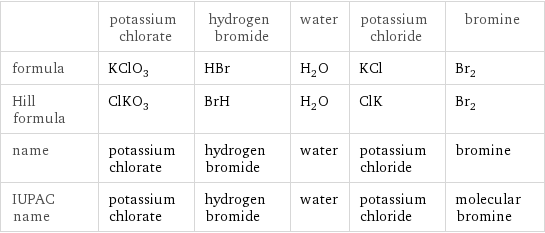
| potassium chlorate | hydrogen bromide | water | potassium chloride | bromine formula | KClO_3 | HBr | H_2O | KCl | Br_2 Hill formula | ClKO_3 | BrH | H_2O | ClK | Br_2 name | potassium chlorate | hydrogen bromide | water | potassium chloride | bromine IUPAC name | potassium chlorate | hydrogen bromide | water | potassium chloride | molecular bromine
Substance properties
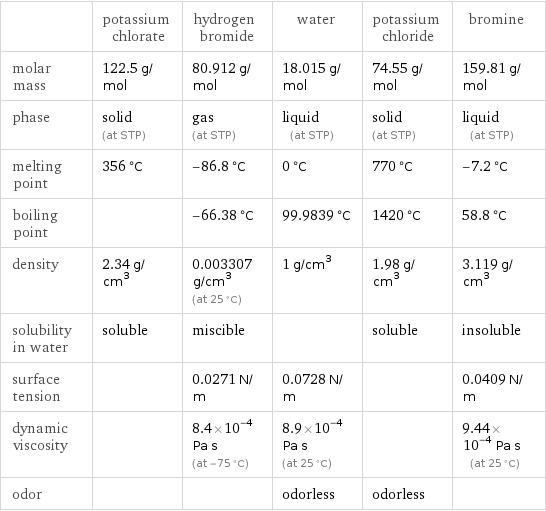
| potassium chlorate | hydrogen bromide | water | potassium chloride | bromine molar mass | 122.5 g/mol | 80.912 g/mol | 18.015 g/mol | 74.55 g/mol | 159.81 g/mol phase | solid (at STP) | gas (at STP) | liquid (at STP) | solid (at STP) | liquid (at STP) melting point | 356 °C | -86.8 °C | 0 °C | 770 °C | -7.2 °C boiling point | | -66.38 °C | 99.9839 °C | 1420 °C | 58.8 °C density | 2.34 g/cm^3 | 0.003307 g/cm^3 (at 25 °C) | 1 g/cm^3 | 1.98 g/cm^3 | 3.119 g/cm^3 solubility in water | soluble | miscible | | soluble | insoluble surface tension | | 0.0271 N/m | 0.0728 N/m | | 0.0409 N/m dynamic viscosity | | 8.4×10^-4 Pa s (at -75 °C) | 8.9×10^-4 Pa s (at 25 °C) | | 9.44×10^-4 Pa s (at 25 °C) odor | | | odorless | odorless |
Units
